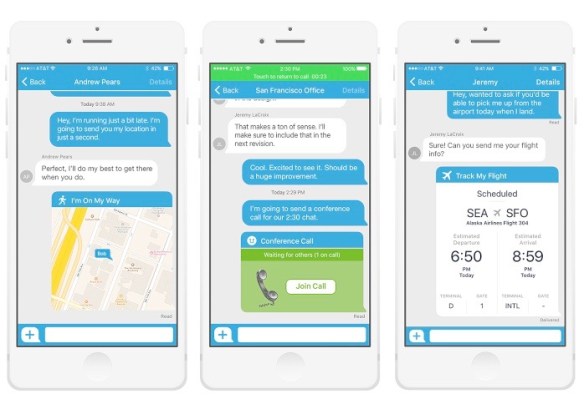Cola, a messaging app that integrates apps into chats, is opening up its developer kit today to enable anyone to build new apps.
The updated version available today comes with 12 “bubbles” that are essentially applications that run inside the messaging app. Users can share weather and flight information, gifs, and more without creating accounts with individual tools. The company’s priority is to reduce the barriers to accomplishing basic tasks with others. Think shared to-do lists where two people can check off items without leaving the messaging app.
In addition to the new bubbles from Cola, developers will be able to use bubble development kits to create new features for the messenger. Similar to Apple’s App Store, Cola has an approval process in place to protect users.
The 10-person team has been developing Cola since 2014 and users have had access to the application since March of this year. Late last year, Naval Ravikant led a $1.3 million seed round, with participation from Ravikant’s AngelList syndicate, which includes AOL founder Steve Case.
Cola isn’t the first company to posit platformization of messaging clients. Heymarket is developing a messaging platform with built-in, app-like templates for small business owners to engage with clients. Atlassian’s HipChat offers Slack like messaging for teams featuring integration with Dropbox, Github, Trello, BlueJeans and even Uber.
In an attempt to find market whitespace, Cola is targeting consumers. While its services are unique, it is still fundamentally competing with Facebook Messenger, Apple’s iMessage, GroupMe, WeChat, and others.
One limitation of Cola is that you have to be inside the app to find and send content. If you want to send a gif, you cannot open it in Giphy. Users of Cola would need to use the Giphy bubble to send it. Moreover, to take full advantage of the integrations, both sender and receiver must have Cola downloaded.
The app’s UI is very basic, though the added simplicity is more of a benefit than a drawback. It’s not quite the material design we are all used to, but it works and isn’t distracting.
From an engineering standpoint, each bubble runs inside its own sandbox so users don’t need to worry about one failed message taking down the entire app. Cola leverages open source technology being led by Facebook called React Native to keep its service running smoothly. Developers will create native “bubble” applications in java script.
Cola’s bubbles are useful, but it’s going to need a killer feature to draw in a critical mass of users. Opening up development to outsiders increases the likelihood that Cola will become host to features users don’t just want but need.
